Key takeaways:
- Effective preservation methods for vintage toys include climate control, gentle cleaning, and careful storage in acid-free materials.
- Preserving vintage toys safeguards cherished memories and contributes to understanding cultural history, enhancing emotional connections.
- Different materials such as wood, metal, and plastic require specific cleaning techniques to maintain their condition and value.
- Regular inspections and protecting toys from sunlight and environmental damage are essential for maintaining their value over time.

Understanding toy preservation methods
When it comes to preserving vintage toys, a variety of methods can be employed, each tailored to the unique materials and construction of the specific piece. For instance, I once stumbled upon an old tin robot that spoke to my childhood memories. To keep it in pristine condition, I discovered that gentle cleaning with a soft cloth and a mild detergent did wonders—it felt rewarding to see it shine once again!
One method that often resonates with collectors is climate control. Keeping toys in a stable environment—away from extreme heat, cold, and humidity—is crucial. I vividly recall losing a cherished vinyl figurine to mold because I underestimated the need for proper storage. It’s a reminder that sometimes, simple precautions can make all the difference in maintaining our beloved collectibles.
Another effective technique involves carefully wrapping toys in acid-free tissue or placing them in display cases. I still remember the thrill of opening a box sealed with care, discovering a childhood treasure safely stored away. Have you ever experienced that joy? The right preservation method not only protects the item but also enhances the story that comes with it, making every piece feel alive with nostalgia.
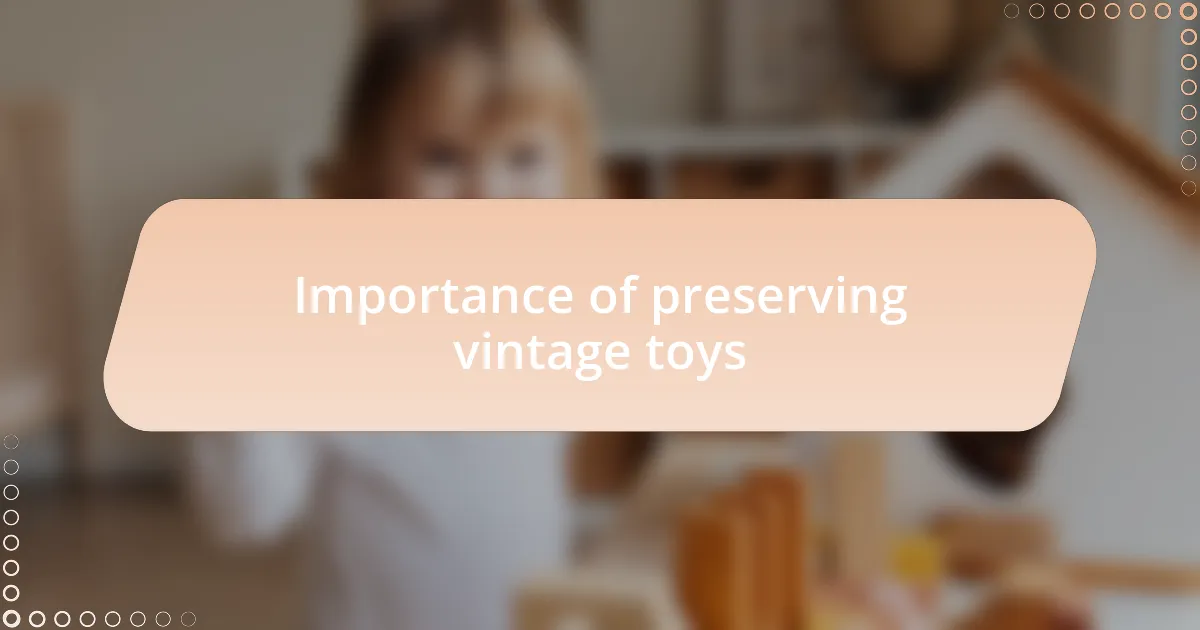
Importance of preserving vintage toys
Preserving vintage toys goes beyond mere collection; it safeguards memories that are wrapped up in each item. I still have my first action figure from childhood, and every time I glance at it, I’m instantly transported back to carefree days of imagination. This emotional connection makes preservation vital; it holds the power to keep those cherished moments alive for future generations to experience.
Furthermore, vintage toys can surprisingly hold significant value, not just financially but as pieces of cultural history. I discovered this when I attended a toy fair and saw a beaten-up teddy bear selling for an incredible amount simply due to its historical significance and rarity. It made me realize that by preserving these toys, we’re not only maintaining sentimental value but also contributing to the larger narrative of childhood and play throughout the decades.
Lastly, preserving these relics fosters a community of enthusiasts who appreciate the artistry and craftsmanship of bygone eras. Engaging in conversations with fellow collectors often reveals fascinating insights about toys I might have otherwise overlooked. Have you ever felt the motivation that comes from connecting over a shared passion? That sense of camaraderie makes protecting these toys all the more meaningful.
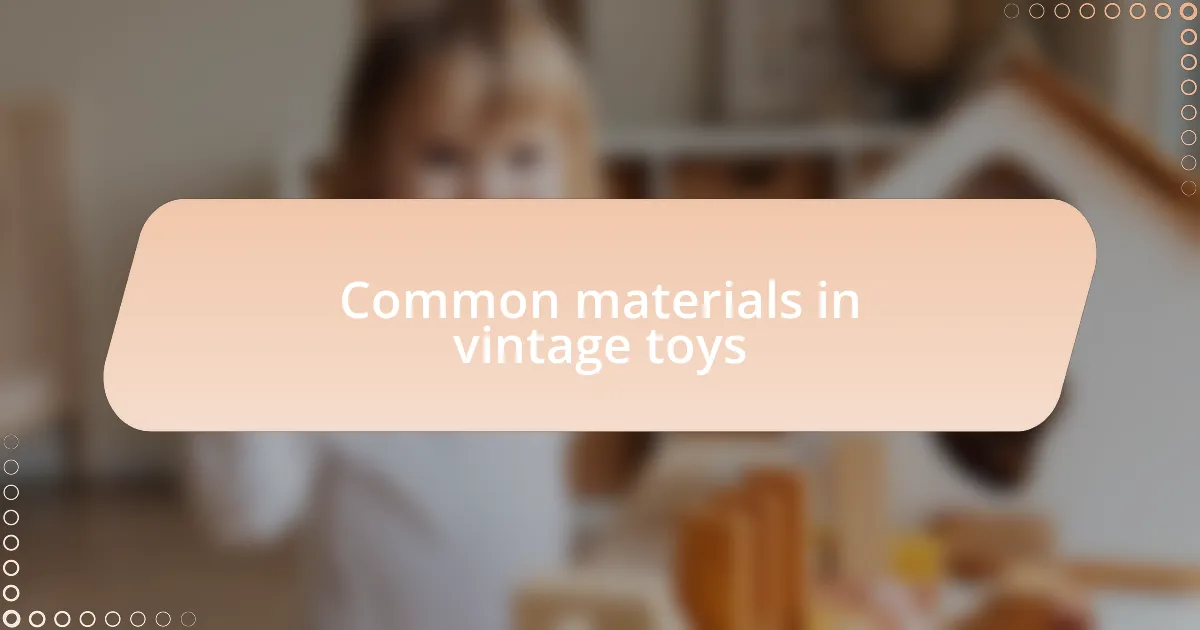
Common materials in vintage toys
When I think about the common materials used in vintage toys, the first thing that comes to mind is the delightful charm of wood. Many early toys like spinning tops and pull-along animals were crafted from wood, giving them a warmth and sturdy feel that plastic can’t quite replicate. I remember my wooden blocks, each one a unique character, their texture soft yet solid. Isn’t it fascinating how these toys not only survive the test of time but also carry the distinct scent of aged timber?
Next, there’s the undeniable role of metal in shaping the toy landscape during the mid-20th century. Tin toys, often adorned with vibrant lithographed designs, evoke a sense of nostalgia that’s hard to ignore. I still have a wind-up tin robot that I found at a flea market; each time I wind it up, I reminisce about the mechanical wonder that defined my childhood. Don’t you think it’s incredible how these toys connect us to different eras and evoke memories with their simple yet captivating mechanisms?
Of course, we can’t overlook plastic, which revolutionized toy production in the late 20th century. It’s amazing to consider that iconic playsets and action figures, which seem to dominate the toy world today, emerged during this shift. I recall unwrapping my first set of action figures, marveling at how lightweight yet detailed they were. It makes me ponder: will future generations look back on today’s toys with the same mix of wonder and nostalgia?
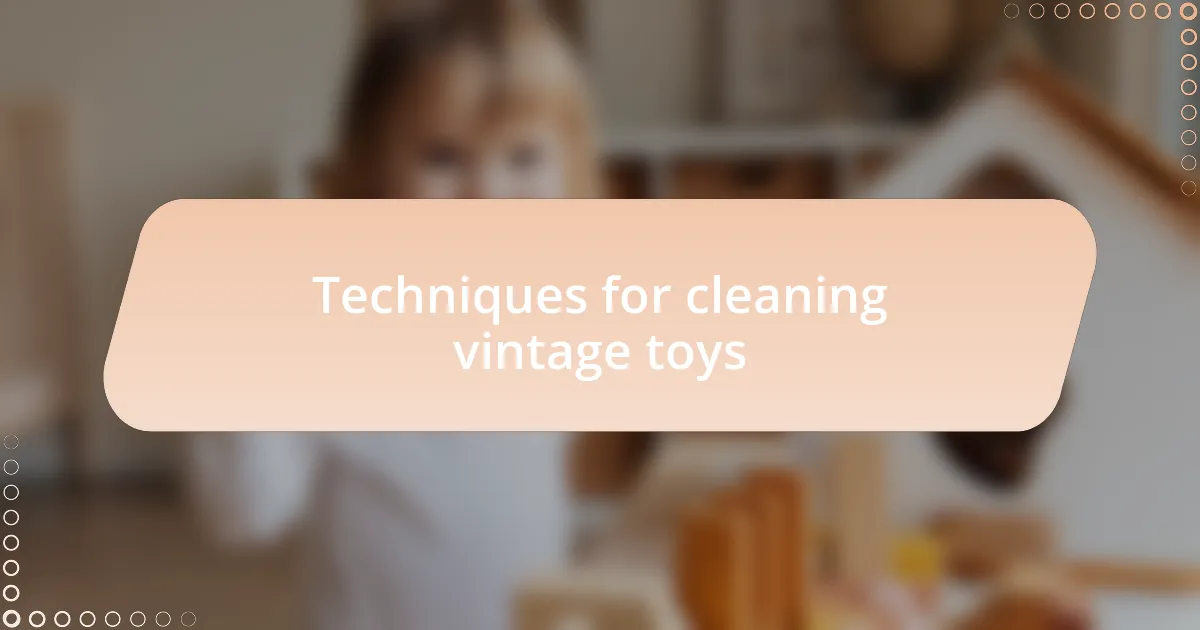
Techniques for cleaning vintage toys
Cleaning vintage toys requires a delicate approach, especially when considering the materials involved. For wooden toys, I often use a soft, damp cloth to wipe away dust, followed by a gentle polish with a natural beeswax solution. This beautifully brings out the grain, making old toys feel alive again. Have you ever noticed how a little wax can transform the way a toy shines?
When it comes to metal toys, a different strategy is key. I usually rely on a mixture of warm water and mild soap for most tin pieces, avoiding anything abrasive that might scratch the surface. There’s something satisfying about seeing the tin shine after a good clean. I remember cleaning my grandfather’s old tin cars—each fresh scrub revealed paint details that I hadn’t seen before, igniting stories of the past in my mind.
For plastic toys, I’ve found that soaking them in soapy water can work wonders. After a short soak, a soft brush helps remove stubborn grime without causing any damage. I think back to the joy of restoring my childhood action figures; seeing them clean and vibrant again brought back so many fond memories. How has reviving an old toy made you feel connected to your past?
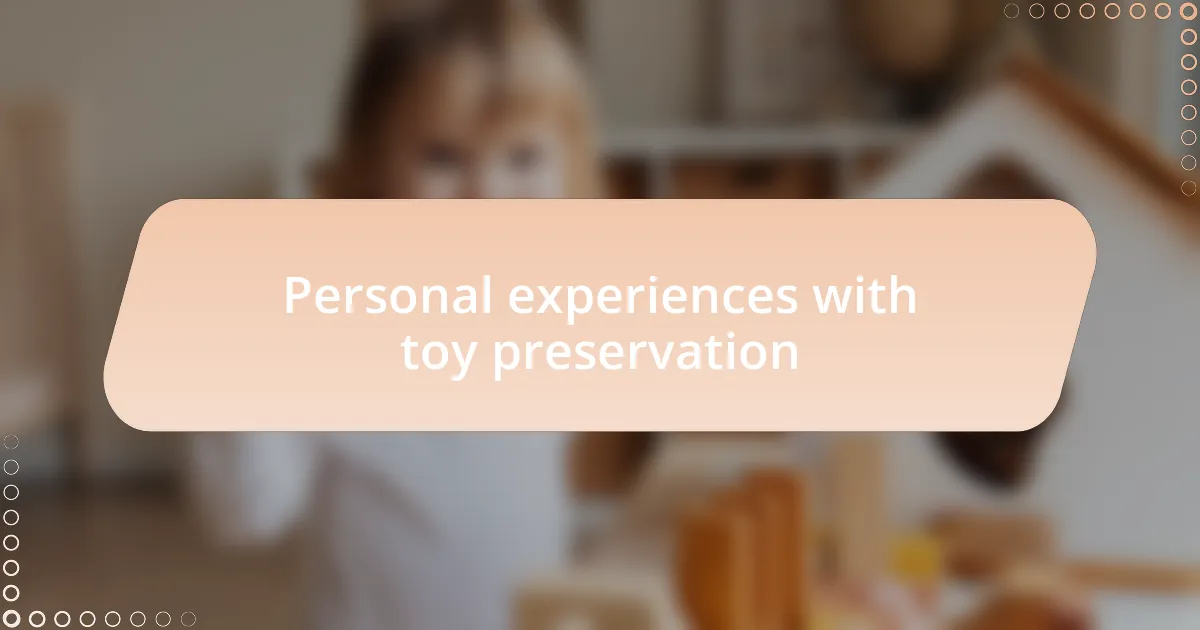
Personal experiences with toy preservation
As I’ve delved deeper into toy preservation, I’ve realized that storage is just as vital as cleaning. I remember the day I discovered my childhood toys stuffed in a cardboard box in the attic, covered in dust and losing their charm. Now, I carefully store them in acid-free containers, surrounded by soft fabric. It’s like creating a little museum of my memories. Have you ever thought about what can happen to toys when they’re not preserved properly?
On a particularly nostalgic day, I decided to refurbish a battered vintage doll. As I gently restored her, I felt a wave of emotion wash over me. Each stitch I made reminded me of the love and care my grandmother poured into her when she first gave her to me. This experience taught me that preservation isn’t merely about maintaining objects; it’s about cherishing the stories they carry. How do your toys reflect the moments of joy in your life?
When I reflect on my journey with toy preservation, I often wonder about the lifespan of these cherished items. I took the time to learn about proper humidity and temperature levels, ensuring my toys remain in a stable environment. One hot summer, I noticed some of my vintage plastic toys starting to warp, which was a heartbreaking lesson. Now, I’m proactive. I can’t help but think about the future generations; I hope they’ll enjoy these pieces of history as much as I have. What kind of legacy do you want your toys to hold?
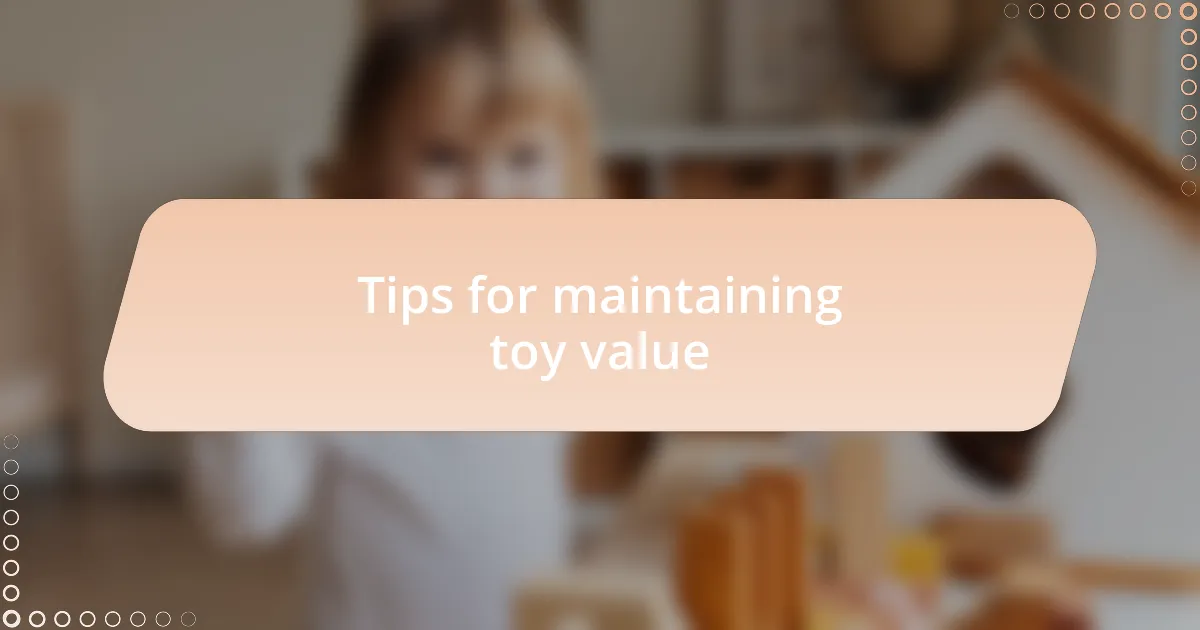
Tips for maintaining toy value
When it comes to maintaining toy value, I’ve found that regular inspections can be invaluable. I remember inspecting my vintage action figures every few months and discovering some minor scratches that could’ve worsened over time. Taking the time to document any wear and tear not only helps in understanding the toy’s condition but also informs any future restoration efforts. Have you checked on your collection lately?
Another strategy that has served me well is ensuring toys are kept away from direct sunlight. I learned this lesson the hard way when I left a rare figurine near a window and noticed the colors fading. That experience taught me the importance of creating an environment where these treasures can shine without succumbing to the sun’s harsh rays. What steps do you take to protect your vintage toys from environmental damage?
Finally, I believe in the importance of retaining original packaging when possible. I recently rediscovered a toy I had saved in its original box, and I marveled at how much more valuable it was than I expected. There’s something special about that original wrapping; it carries the history of the item and adds to its charm. Have you considered how the packaging of your toys impacts their overall value?